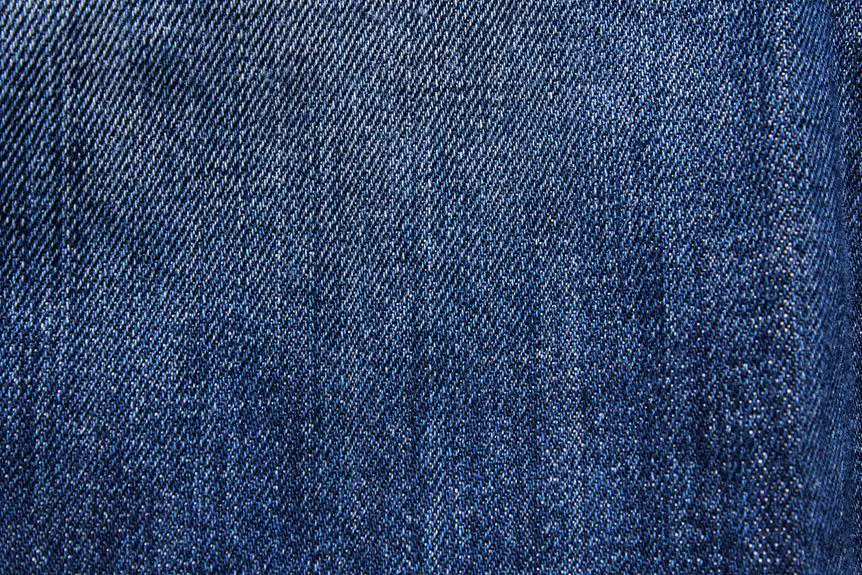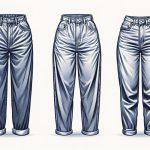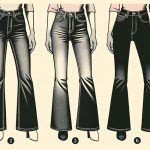Do you ever find your favorite pair of jeans feeling more snug after a few wears? You're not alone.
In 'Does Denim Stretch: The Truth About Fabric Relaxation,' we delve into the science behind denim's tendency to stretch over time. Understanding the factors contributing to fabric relaxation, such as the composition of the denim and the effects of wear and washing, can help you maintain the perfect fit.
This guide provides an in-depth look at debunking common misconceptions and offers tips for choosing the right denim to suit your needs. Whether you're a denim enthusiast or simply seeking to master the art of maintaining your jeans' fit, this exploration is tailored to empower your denim knowledge.
Key Takeaways
- Denim is woven using a twill weave, creating a diagonal ribbing pattern for natural stretch.
- Manufacturers incorporate elastane or spandex into denim fabric for enhanced stretch and recovery.
- Friction, washing, drying, stress points, and environmental factors contribute to fabric relaxation.
- Fabric composition, including the addition of stretch fibers and the ratio of cotton to synthetic fibers, determines denim's stretchiness and durability.
The Science Behind Denim Stretch
To understand the science behind denim stretch, you need to consider the molecular structure of the fabric and how it interacts with wear and movement.
Fabric behavior is a crucial aspect of denim stretch. Denim is typically woven using a twill weave, which involves interlacing the weft and warp threads. This weaving technique creates a diagonal ribbing pattern that allows the fabric to have some natural stretch.
Additionally, textile engineering plays a significant role in denim stretch. Manufacturers often incorporate a small percentage of elastane or spandex into the denim fabric to enhance its stretch and recovery properties. These elastic fibers work in conjunction with the natural stretch of the twill weave to provide a comfortable and flexible fit.
When the denim is subjected to wear and movement, the molecular structure of the fabric allows it to temporarily stretch and conform to the body, returning to its original state once the stress is removed.
Understanding these fabric behaviors and the principles of textile engineering provides insight into the science behind denim stretch.
Factors Contributing to Fabric Relaxation
As you consider the factors contributing to fabric relaxation, it's important to note that wear and tear can significantly impact the stretch and comfort of denim.
Additionally, the composition of the fabric plays a crucial role in determining its ability to relax over time.
Understanding these factors can help you make informed decisions when choosing denim garments and caring for them to maintain their desired fit and comfort.
Wear and Tear
You may notice that the fabric of denim stretches over time due to repeated washing and wearing. This is primarily caused by wear and tear on the fabric.
Factors contributing to fabric relaxation include:
- Friction from daily activities and movement gradually wears down the fibers.
- Washing and drying denim can lead to the breakdown of the fabric's structure.
- Stress points such as pockets and seams are prone to stretching and weakening.
- Environmental factors like heat and humidity can impact the fabric's elasticity.
- Regular use of stretching techniques, such as squatting or bending, can strain the fabric over time.
Understanding these factors can help you take better care of your denim and prolong its durability.
Fabric Composition
Fabric composition plays a crucial role in how denim stretches over time, impacting its overall durability and comfort. The flexibility of denim fabric is influenced by its composition, particularly the textile structure and the materials used.
For instance, the addition of stretch fibers like elastane or spandex improves the fabric's ability to stretch and recover, enhancing its comfort and fit. Additionally, the weave structure of denim, such as twill or satin weaves, can also affect its stretch properties.
Moreover, the ratio of cotton to synthetic fibers in the fabric blend can contribute to its overall stretchiness and resilience. Understanding the fabric composition and its impact on fabric flexibility is essential for making informed decisions about the denim garments you choose, ensuring they meet your comfort and durability expectations.
Understanding Fabric Composition
When it comes to understanding fabric composition, it's important to consider the concept of fabric elasticity and its impact on stretch.
The fabric content plays a crucial role in determining how much a fabric can stretch and relax over time.
In the case of denim, the specific blend of fibers can greatly influence its ability to stretch and mold to the body.
Fabric Elasticity Explained
Understanding the composition of fabric and its elasticity can significantly impact your clothing choices and comfort. Fabric tension and material flexibility are crucial aspects to consider when selecting garments.
To comprehend fabric elasticity, it's essential to delve into the composition of the material. Here are key points to consider:
- Fiber Type: Different fibers, such as cotton, polyester, or spandex, have varying levels of elasticity.
- Weave Structure: The way the fabric is woven affects its stretch and recovery capabilities.
- Blend Ratio: The combination of different fibers in a fabric blend influences its overall elasticity.
- Fabric Weight: Heavier fabrics tend to have less stretch compared to lighter weight materials.
- Finishing Techniques: Treatments like mercerization or enzyme washing can impact the fabric's elasticity.
Understanding these factors empowers you to make informed decisions when choosing garments for optimal comfort and style.
Impact of Fabric Content
Exploring the impact of fabric content on stretch and recovery is essential for making informed clothing choices that prioritize comfort and style.
Fabric composition directly influences the garment's stretch resistance and durability. For instance, natural fibers like cotton and wool offer excellent breathability and comfort but may lack the same level of stretch durability as synthetic fibers.
On the other hand, synthetic fibers like polyester and elastane provide enhanced stretch resistance, making them ideal for form-fitting clothing.
Understanding the fabric content in your garments empowers you to select clothing that aligns with your lifestyle and preferences. By considering fabric durability and stretch resistance, you can make informed decisions that ensure your clothing provides both comfort and longevity, ultimately enhancing your overall style and satisfaction.
Stretch in Denim
As you consider the stretch in denim, it's important to understand how fabric composition directly influences its flexibility and durability. Denim stretch depends on various factors, such as the blend of materials and the method of weaving. Here are key elements to consider:
- Fiber Content: Different fibers, like cotton, polyester, and elastane, affect the stretch and recovery of denim.
- Weave Structure: The way the yarns are intertwined impacts the fabric's ability to stretch while maintaining its shape.
- Percentage of Stretch Material: The amount of elastane or spandex in the denim determines its stretchiness.
- Durability: A balance between stretch and durability is crucial to prevent fit issues and ensure longevity.
- Sizing Concerns: Understanding the stretch properties helps in choosing the right size to avoid fit problems.
Understanding these aspects can help you make informed decisions when selecting denim for the perfect fit.
Effects of Wear and Washing
Washing and wearing denim regularly can significantly impact its stretch and fit over time. When it comes to washing techniques, it's essential to follow the care instructions provided by the manufacturer to maintain the integrity of the fabric. Using a gentle cycle with cold water and a mild detergent can help preserve the color and prevent excessive wear. Additionally, turning the denim inside out before washing can further protect the fabric from abrasion and fading.
As for fabric care, avoiding frequent washing can also help maintain the shape and stretch of denim. Spot cleaning stains and odors whenever possible can reduce the need for frequent washing, ultimately prolonging the life of the denim.
When it comes to drying denim, air drying is preferable to using a dryer, as high heat can affect the elasticity of the fabric.
Tips for Maintaining the Perfect Fit
To maintain the perfect fit of your denim, regularly try on your jeans to assess their comfort and stretch. This will help you detect any signs of sagging or loss of shape early on, allowing you to take corrective measures promptly.
Here are some tips for maintaining the ideal fit of your denim:
- Wash your jeans inside out to prevent fading and maintain their shape.
- Air-dry your denim instead of using a dryer to avoid unnecessary stretching.
- Consider spot cleaning instead of washing your jeans frequently to preserve their fit.
- Store your denim flat or folded to prevent stretching on hangers.
- If your jeans start to sag slightly, try steaming them to regain their original shape.
Myth Busting: Common Misconceptions
Common misconceptions about denim stretching often lead to improper maintenance and fit-related issues. Let's debunk some myths to help you understand the truth about fabric durability.
One common misconception is that washing denim in hot water will prevent it from stretching. In reality, hot water can break down the fibers in the fabric, leading to decreased durability and an increased likelihood of stretching.
Another myth is that all denim stretches the same way. Different types of denim, such as raw and pre-washed, have unique characteristics that affect how they stretch. It's essential to understand the specific properties of the denim you're working with to ensure proper maintenance and fit.
Additionally, some believe that stretching denim while it's wet will help it conform to your body better. However, stretching wet denim can actually cause it to lose shape and elasticity over time.
Choosing the Right Denim for You
When selecting the right denim for your needs, it's important to understand the unique characteristics of different types of denim and how they can impact the fabric's stretch and durability. Finding the right fit is essential for comfort and style, and proper denim maintenance can significantly extend the lifespan of your favorite pair.
Here are some key factors to consider when choosing the right denim:
- Fabric Composition: Different denim fabrics have varying levels of stretch and durability. Look for fabric blends that offer the stretch you need while maintaining shape and resilience.
- Cut and Style: The cut and style of denim can greatly affect how it fits your body. Consider your body shape and personal style preferences when choosing between skinny, straight, bootcut, or boyfriend jeans.
- Color and Wash: The color and wash of denim can impact its versatility and overall look. Dark wash denim tends to be more formal, while distressed or light wash denim offers a more casual vibe.
- Brand and Quality: Investing in high-quality denim from reputable brands can ensure better fit, comfort, and longevity.
- Care Instructions: Understanding the proper care and maintenance of your denim is crucial for preserving its shape and color. Follow the manufacturer's care instructions to keep your denim looking great for longer.
Frequently Asked Questions
How Do I Know if My Denim Is Stretching Too Much?
If your denim feels excessively loose and loses shape, it may be stretching too much. Proper denim care and high-quality fabric are crucial. Check for a tight fit when buying and follow care instructions to maintain shape and elasticity.
Can I Prevent My Denim From Stretching Out?
To prevent denim from stretching out, prioritize proper denim maintenance. Wash in cold water, avoid high heat when drying, and store flat or hung to maintain shape. Regularly wearing and washing can lead to slight stretching, but careful care can minimize this.
What Is the Best Way to Wash and Dry Denim to Maintain Its Original Fit?
To maintain the original fit of your denim, wash inside out in cold water and air dry. Avoid using the dryer as it can lead to stretching. Following these washing techniques and drying methods will help preserve the fabric's shape.
Are There Any Specific Denim Brands or Types That Are Less Prone to Stretching?
When it comes to denim brands, some are known for being less prone to stretching. Look for stretch-resistant types like raw denim and consider maintenance techniques such as air-drying and avoiding excessive heat. Repair methods can also help maintain the original fit.
Is There a Way to Repair Stretched Out Denim?
Yes, you can repair stretched out denim using DIY solutions. Denim repair can be done by reinforcing seams, adding darts, or inserting elastic panels. These methods can help restore the original fit of your denim.
- Does Chiffon Fabric Stink - July 15, 2025
- Does Chiffon Fabric Affect the Economy - July 15, 2025
- Does Cotton Fabric Have a Nap - July 15, 2025






